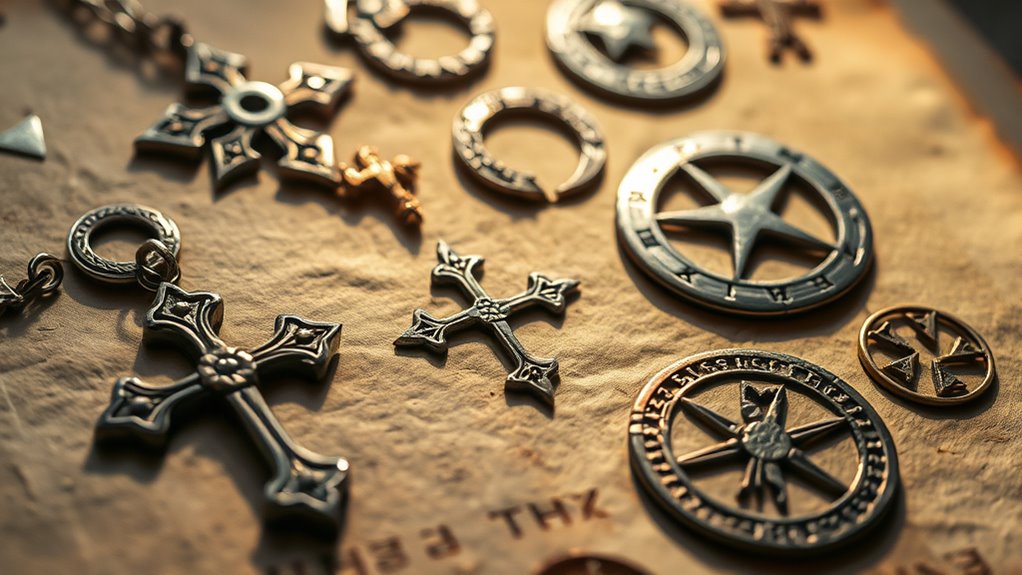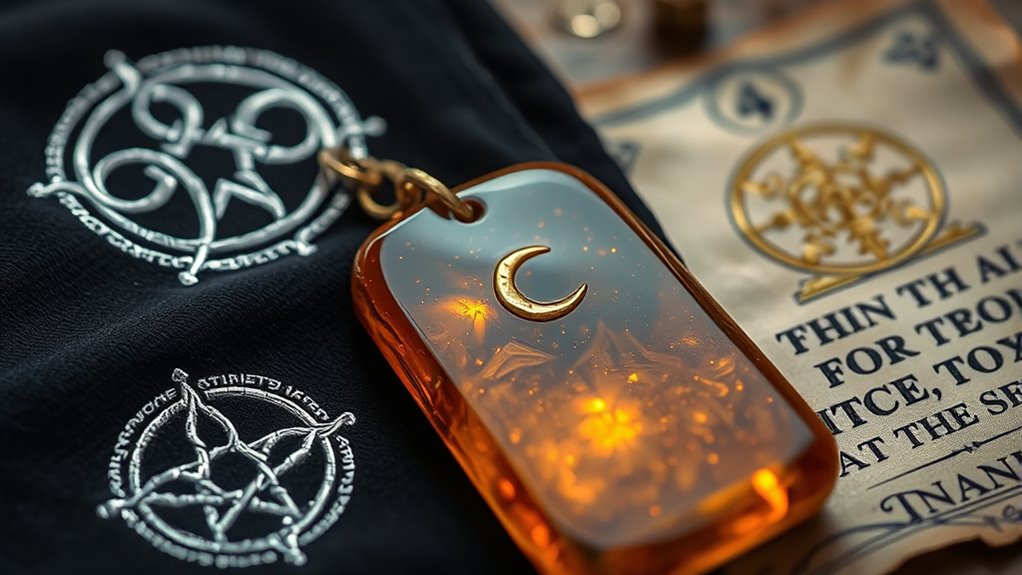Symbols of protection like sigils, talismans, and holy signs serve to ward off harm and strengthen your spiritual defenses. They act as visual reminders of divine or cultural energy, creating a barrier against negative influences. By intentionally using or displaying these symbols, you reinforce your sense of safety and resilience. Whether carved, drawn, or worn, each carries deep meaning and personal power—if you explore further, you’ll discover how these symbols can truly shield and empower you.
Key Takeaways
- Symbols of protection include sigils, talismans, and holy signs that ward off negative energies and evil influences.
- They are often created or blessed through rituals, prayers, or cultural practices to enhance their protective power.
- Sacred symbols serve as visual reminders of spiritual safeguarding and can be worn, drawn, or displayed for defense.
- Personalizing symbols with specific intentions strengthens their effectiveness and emotional resilience.
- Incorporating cultural or spiritual significance into symbols deepens their protective qualities and connection to tradition.

Have you ever wondered why certain symbols are believed to ward off harm or bring safety? Throughout history, people have turned to symbols like sigils, talismans, and holy signs to protect themselves from danger. These symbols serve as amulets of safety—powerful objects or markings believed to create a shield against negative energies or evil influences. Sacred emblems, whether carved, drawn, or worn, carry a deep spiritual significance and are often infused with intention or ritual to enhance their protective qualities. You might find these symbols in different cultures, each with its unique form and meaning, but all sharing a common purpose: safeguarding the wearer or space from harm.
Symbols like sigils, talismans, and holy signs serve as powerful amulets to ward off harm and protect from negative energies.
Many cultures have relied on sacred emblems as a form of spiritual armor. For example, a cross or a hamsa hand can act as a talisman of protection, believed to ward off evil spirits or malicious intent. These symbols aren’t just decorative; they’re thought to hold sacred power, connecting the physical and spiritual dimensions. When you wear or display such symbols, you’re essentially carrying a visual reminder of divine protection. The act of wearing an amulet of safety isn’t just superstition but a way to focus your intentions and reinforce your sense of security. The sacred emblems are often consecrated through rituals, prayers, or blessings, which imbues them with their protective energy, making them more than mere objects. Additionally, holistic approaches to health and wellness often include the use of symbols to promote emotional and spiritual balance. Recognizing the cultural significance behind these symbols can deepen your understanding of their protective power. Incorporating cultural symbols into your personal space or attire can also serve to strengthen your protective mindset. Furthermore, some symbols are believed to absorb or deflect negative energies, acting as a barrier against harmful influences and enhancing their effectiveness through intention.
Sigils, on the other hand, are symbols created with specific intentions, often personalized, to serve as protectors. You might create or use a sigil that embodies a protective intention—like shielding from harm or negative influences—and keep it close. These symbols act as visual anchors, reinforcing your mental and spiritual defenses. When you see or hold these sacred emblems, you’re reminded of your intention to stay safe, which can bolster your confidence and sense of security. The power of these symbols lies in their ability to focus your mind and reinforce your protective beliefs. Over time, many find that these symbols develop a personal significance, becoming talismans that provide comfort and reassurance in times of need.
In reality, symbols of protection—whether as amulets of safety, sacred emblems, or sigils—serve as tangible representations of unseen spiritual forces. They connect you to a tradition of safeguarding that spans cultures and centuries, providing a sense of comfort and strength. Whether worn, displayed, or drawn, these symbols act as visual reminders of protection, empowering you to face life’s uncertainties with confidence. Their enduring presence proves that, sometimes, a simple symbol can carry profound protective power. By understanding the origins and meanings behind these symbols, you can better harness their potential for personal security. When choosing or creating protective symbols, it’s helpful to consider their cultural context and the intentions you wish to imbue them with, such as spiritual protection or emotional resilience. Exploring the history of symbols can deepen your appreciation of their significance and effectiveness.
Frequently Asked Questions
Can Anyone Create Their Own Protective Symbols Effectively?
You can definitely create your own protective symbols effectively. Personal symbolism allows you to infuse meaning and intention into your designs, making them more powerful. Keep in mind cultural variations, which influence symbol meanings and practices around protection. Trust your intuition, choose symbols that resonate with you, and focus on your intent. With practice, your unique symbols can become potent tools for safeguarding yourself and your space.
Are There Cultural Differences in Interpreting Protective Symbols?
You’ll find that cultural symbolism greatly influences how protective symbols are interpreted. Different cultures assign unique meanings to similar signs, leading to interpretive differences. For example, a symbol that signifies protection in one tradition might symbolize something entirely different elsewhere. These cultural nuances shape your understanding, so it’s important to contemplate the origins and context behind each symbol to truly grasp its protective significance across various cultures.
Do Protective Symbols Have Scientific Backing for Their Efficacy?
Think of protective symbols as psychological shields rather than physical barriers. While symbol psychology shows they can boost confidence and reduce anxiety, scientific evidence for their direct efficacy remains limited. The placebo effect often plays a role, where belief in their power creates real emotional comfort. You might find that, whether symbolic or scientific, your mindset influences how protected you feel—making symbols powerful in their own right.
How Should One Cleanse or Deactivate a Protective Sigil?
To cleanse a protective sigil, you should focus on symbol cleansing techniques like visualizing the removal of its energy or using physical methods such as rinsing or burning. For sigil deactivation, you might erase or destroy it intentionally, ensuring no residual energy remains. These steps help deactivate the sigil’s protective power, providing a clear mental and energetic boundary. Remember, your intent plays a vital role in this process.
Can Protective Symbols Be Combined for Enhanced Security?
You might wonder if combining protective symbols can boost security. Using symbol combinations can create a layered defense, strengthening the overall protection. When you carefully blend different sigils, talismans, or holy signs, each adds its unique energy, making the protective barrier more powerful. Just be mindful to keep the symbols harmonious and purposeful, as this enhances security without causing confusion or weakening the individual symbols’ effectiveness.
Conclusion
So, next time you’re feeling vulnerable, just whip out a sigil, toss a talisman around your neck, or flash a holy sign—because clearly, a little engraved magic is all you need to fend off life’s chaos. Who needs therapy or common sense when symbols can do all the heavy lifting? Just remember, if it doesn’t work, it’s probably because your cat stole your lucky charm again. Stay protected, or at least look busy trying.









